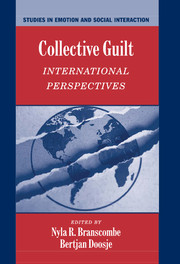Book contents
- Frontmatter
- Contents
- Preface
- List of Contributors
- Collective Guilt
- Section 1 Defining the nature of collective guilt
- 1 International Perspectives on the Experience of Collective Guilt
- 2 The Measurement of Collective Guilt: What It Is and What It Is Not
- 3 The Evocation of Moral Emotions in Intergroup Contexts: The Distinction Between Collective Guilt and Collective Shame
- 4 Collective Guilt in the United States: Predicting Support for Social Policies that Alleviate Social Injustice
- 5 Gender Inequality and the Intensity of Men's Collective Guilt
- Section 2 The Relationship Between Group Identification and Collective Guilt
- Section 3 Consequences for Intergroup Relations
- Section 4 Commentary on the Volume
- Index
- References
2 - The Measurement of Collective Guilt: What It Is and What It Is Not
Published online by Cambridge University Press: 05 January 2012
- Frontmatter
- Contents
- Preface
- List of Contributors
- Collective Guilt
- Section 1 Defining the nature of collective guilt
- 1 International Perspectives on the Experience of Collective Guilt
- 2 The Measurement of Collective Guilt: What It Is and What It Is Not
- 3 The Evocation of Moral Emotions in Intergroup Contexts: The Distinction Between Collective Guilt and Collective Shame
- 4 Collective Guilt in the United States: Predicting Support for Social Policies that Alleviate Social Injustice
- 5 Gender Inequality and the Intensity of Men's Collective Guilt
- Section 2 The Relationship Between Group Identification and Collective Guilt
- Section 3 Consequences for Intergroup Relations
- Section 4 Commentary on the Volume
- Index
- References
Summary
Emotions can be ephemeral. How events are appraised and the subjective experience they generate can rapidly shift with changes in the social context. In order to capture people's emotional responses to events, psychologists have employed a variety of methods including the assessment of facial expressions (Ekman, 1984), physiological reactivity (Pennebaker, 1982) and, most commonly, self-report methods (Shaver et al., 1987). Particularly for the self-conscious emotions of pride, shame, and guilt, for which differential physiological symptoms are not expected, researchers have primarily relied on various participant self-assessments (Tangney & Fischer, 1995). Individual differences in the tendency to experience these emotions are generally assessed via self-ratings of the frequency, duration, or intensity with which they are felt. Indices that capture agreement or disagreement with Likert-type statements concerning how much the emotion is experienced with respect to a particular referent are also often employed. In this chapter, we report on the construction and validation of a self-report scale to assess various aspects of the collective guilt experience.
Theoretical bases of guilt
There is considerable agreement concerning the antecedent conditions that are necessary for personal guilt to be experienced. Weiner (1995) argues that guilt is most likely to be experienced when the self is seen as responsible for a negative outcome. From an attribution perspective, guilt occurs when an internal attribution is made for a controllable negative outcome that results in harm to another.
- Type
- Chapter
- Information
- Collective GuiltInternational Perspectives, pp. 16 - 34Publisher: Cambridge University PressPrint publication year: 2004
References
- 104
- Cited by

